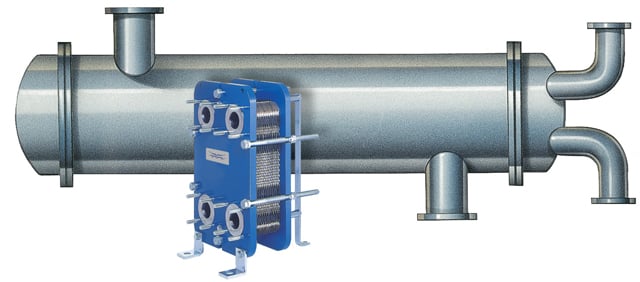Introduction
Gasketed Plate Heat Exchanger vs Shell and Tube Heat Exchanger are the most widely used due to their ability to transfer heat efficiently between two fluids. However, their design, efficiency, cost, maintenance, and application suitability differ significantly. A Gasketed Plate Heat Exchanger (GPHE) consists of multiple thin, corrugated metal plates held together by gaskets, which create separate flow channels for hot and cold fluids. These heat exchangers are known for their compact size, high efficiency, and ease of maintenance, making them a preferred choice for applications with space constraints and frequent cleaning requirements. A Shell and Tube Heat Exchanger (S&T) consists of a bundle of tubes enclosed in a cylindrical shell, where one fluid flows inside the tubes and the other flows around them. These heat exchangers are widely used in industries requiring high pressure and temperature resistance, such as power plants, oil refineries, and heavy industrial processes. Heat exchangers play a crucial role in industries requiring efficient thermal energy transfer. They are used in HVAC systems, power plants, chemical processing, food and beverage production, pharmaceuticals, and oil & gas industries.
Detailed Comparison of GPHE vs. Shell and Tube Heat Exchangers
Heat Transfer Efficiency
- Gasketed Plate Heat Exchanger (GPHE):
- Offers higher heat transfer efficiency due to thin plates and high turbulence in the flow paths.
- The corrugated plate design ensures a large surface area per unit volume, maximizing heat transfer.
- Works efficiently with low-temperature differences, making it suitable for applications requiring precise thermal control.
- Shell and Tube Heat Exchanger (S&T):
- Has lower heat transfer efficiency compared to GPHE due to laminar flow inside the tubes.
- Requires a larger unit size to achieve the same heat transfer performance as a GPHE.
- More suitable for applications where heat duty is more important than space-saving.
Verdict: GPHE is more efficient in heat transfer due to its large surface area and turbulent flow, while S&T is better for applications requiring long-term durability over high efficiency.
Space Requirements
- GPHE:
- Compact and space-saving due to its plate-based design, making it ideal for areas with installation space constraints.
- Can be installed vertically or horizontally, allowing flexible integration into existing systems.
- S&T:
- Requires significantly more space due to the cylindrical shell and tube design.
- The length of the unit increases with higher heat transfer requirements, making it difficult to install in compact areas.
Verdict: GPHE is the preferred choice when space is limited, whereas S&T requires a dedicated area for installation.
Maintenance and Cleaning
- GPHE:
- Easier to clean and maintain, as the plates can be individually removed for inspection and cleaning.
- Suitable for applications that require frequent maintenance (e.g., food and pharmaceutical industries).
- However, gasket replacements may be needed over time, adding to maintenance costs.
- S&T:
- Difficult to clean, as internal tube surfaces require chemical cleaning or mechanical brushing.
- Cleaning the shell side is easier, but tubes may need to be removed for thorough maintenance.
- Maintenance requires shutdown of the system, making it less suitable for industries requiring continuous operation.
Verdict: GPHE is easier and faster to clean, whereas S&T requires more effort and downtime for maintenance.
Pressure and Temperature Handling
- GPHE:
- Limited to moderate pressures (up to ~25 bar) and temperatures (~150°C) due to gasket constraints.
- Not suitable for applications involving extremely high temperatures or aggressive chemicals that can degrade gaskets.
- S&T:
- Can handle high pressures (up to ~100 bar) and high temperatures (~600°C), making it ideal for heavy-duty industries.
- Resistant to thermal shocks and pressure fluctuations, ensuring long-term reliability in extreme conditions.
Verdict: S&T is superior for applications requiring high pressure and temperature resistance, while GPHE is better for moderate temperature and pressure applications.
Scalability and Expansion
- GPHE:
- Easily expandable by adding extra plates to increase heat transfer capacity.
- More cost-effective for future expansions, as only additional plates need to be installed.
- S&T:
- Fixed design, requiring a completely new unit if expansion is needed.
- Less flexible for future capacity upgrades.
Verdict: GPHE is more scalable and cost-effective for growing industrial needs, while S&T is less adaptable.
Leakage Risk
- GPHE:
- Higher risk of leakage due to gasket deterioration over time.
- Requires frequent gasket replacements to prevent leaks.
- S&T:
- Lower leakage risk, especially in designs with welded tube sheets or fixed tubes.
- Suitable for hazardous and toxic fluid applications where leaks must be avoided.
Verdict: S&T is better for high-risk applications involving hazardous fluids, while GPHE requires regular gasket maintenance to prevent leaks.
Applications and Industry Use of Gasketed Plate Heat Exchanger vs Shell and Tube Heat Exchanger
- GPHE is best suited for:
- HVAC systems
- Food and beverage processing
- Pharmaceutical cooling
- Chemical industries requiring compact and efficient heat exchangers.
- S&T is ideal for:
- Oil and gas refineries
- Power plants
- Heavy industrial processes
- Marine and petrochemical applications where high-pressure and high-temperature resistance are required.
Verdict: GPHE is used in moderate-duty, clean applications, while S&T is used in heavy-duty, extreme conditions.
Conclusion on Gasketed Plate Heat Exchanger vs Shell and Tube Heat Exchanger
The choice between Gasketed Plate Heat Exchangers (GPHE) and Shell and Tube Heat Exchangers (S&T) depends on specific operational needs:
- Choose GPHE if you need high efficiency, space-saving design, and easy maintenance. It is perfect for industries that require frequent cleaning, lower pressure handling, and compact installations. However, it is not suitable for extreme pressures and high temperatures.
- Choose Shell and Tube Heat Exchangers if you need a durable, high-pressure and high-temperature resistant solution. They are the best option for oil refineries, power plants, and marine applications where operational conditions are extreme. However, they require more maintenance space, are harder to clean, and have lower heat transfer efficiency.
Both heat exchangers have their strengths and weaknesses, and selecting the right type will help industries improve efficiency, reduce costs, and optimize process performance.

